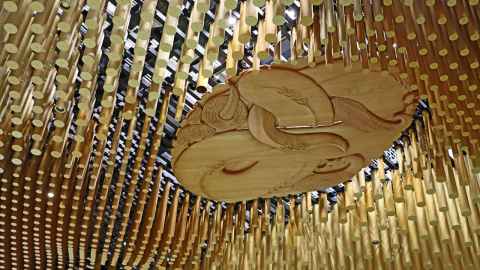Student’s artwork central to new station
1 August 2025
A huge whakairo created by Engineering PhD candidate Paraone Luiten-Apirana now watches over a City Rail Link station.

In the humming heart of Tāmaki Makaurau, beneath the city’s surface, a kaitiaki (guardian) has returned – reborn in kauri and light.
A whakairo (carving) named Horotiu, representing a kaitiaki of the same name, now rests in the ceiling of the City Rail Link’s new Te Waihorotiu Station.
The whakairo is the work of civil engineering PhD candidate Paraone Luiten-Apirana (Ngāti Hikairo, Ngāi Tūhoe, Te Arawa), and the story of its creation began with a patu (hand-held weapon) carved by the kaiwhakairo and an act of reciprocity.
Paraone is a rising star in the world of whakairo, and one of those who saw his potential early on was artist and designer Graham Tipene (Ngāti Whātua Ōrākei, Ngāti Hine).
“I first met Graham at an art exhibition back in 2021,” recalls Paraone. “And I knew then that if I ever got my first tā moko, it would be from him.”
When he later received that tā moko, Paraone carved Graham a patu as a thank you gift. Graham was later commissioned to create artwork for the new station, and the patu that Paraone had carved for him caught his eye. Without hesitation, Graham suggested that Paraone create one of his designs in the project: Horotiu – a whakairo that Paraone describes as “the size of a small car”.
Horotiu is a kaitiaki, originally aiding ancestors in their navigation to Tāmaki Makaurau. Horotiu later took the form of a guardian of Tāmaki’s waters, watching over the city’s streams.
The whakairo Horotiu is embedded in this story. The figure is surrounded by a depiction of raupō (reeds), and glimmers of light behind these mirror the reflection of stars on the water’s surface.
Paraone says the story perfectly suits Horotiu’s location.
“It’s a navigation story. And what better place to tell that than in a train station, where people are constantly arriving, leaving and finding their way,” he says.

Horotiu took six months to bring to life and began with sourcing the right timber. “We went on a trip up North to find it. I’m not a wood expert, so I wasn’t even sure what I was looking for,” laughs Paraone.
But the moment they walked into their second timber yard, Paraone says a kauri slab called to him. That log became the body of Horotiu and introduced another strand to the artwork’s genealogy.
“Kauri and whale are brothers in Māori pūrākau (myth),” explains Paraone. “So while the carving is based on a kaitiaki, it’s also a fusion – part tuna (eel), part whale. The kauri adds its own whakapapa to the work.”
And for the thousands of commuters who will pass by Horotiu each day, perhaps without ever knowing its origin, Paraone hopes the work will still serve its purpose: to guide, protect and connect.
Beyond his work with chisels and timber, Paraone is carving out new spaces through his University research, which explores the evolving relationship between tradition and technology in whakairo.
His research question, ‘What are the implications of using machines (or different/automation technologies) in carving?’, has grown into a rich investigation of materials, tools and the whakapapa of innovation.
His answer to his research question is nuanced.
“Novel technology can create opportunities for whakairo in new spaces, creating accessibility and strengthening Māori identity,” he says. “But my research also looks to celebrate current and ancestral practices.”
He experiments with a range of unexpected tools – from hand forged blades to common garden implements. Holding up a grubber, he says with a grin, “if you just sharpen the edge of this, it’s perfect for defining the contours of wood”, reflecting the innovation exhibited by ancestral tohunga whakairo.
He’s also studying the impact of power tools and digital carving technologies, including CNC routers (computer-controlled cutting machines) and laser cutters, analysing how they compare to the adzes and chisels of old.
Still, he holds firm to the traditional values that ground his practice: whakapapa, wairua and intention.
“The tool might change,” he reflects, “but the story, the tikanga, the connection – that has to stay the same.”
– Te Rina Triponel
This article first appeared in the August 2025 issue of UniNews.